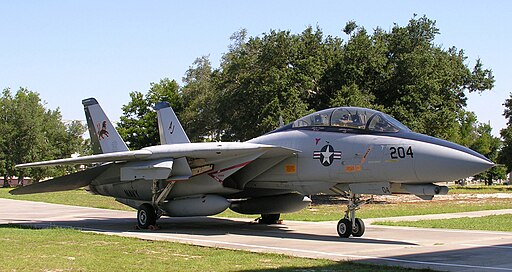When we think of iconic fighter jets, few can rival the F-14 Tomcat as one of aviation history’s most impressive machines. Made famous by “Top Gun”, this iconic aircraft achieved media stardom and was widely known for its astounding performance and significant role in serving United States Navy forces.
Design and Development
Grumman Aerospace Corporation (now Northrop Grumman) developed and introduced into service the F-14 Tomcat aircraft in 1970 as the successor to the F-4 Phantom II fleet defense mission aircraft. Equipped with AWG-9 radar and long-range AIM-54 Phoenix missiles, the F-14 Tomcat proved unbeatable at simultaneously detecting and engaging multiple enemy planes from great distances.
The F-14 stands out for its distinctive variable-sweep wings that could be set back for high-speed intercepts or forward for improved maneuverability and landing performance – giving this iconic fighter jet an advantage in aerial battle and cementing its iconic status.
Service History
The F-14 served the United States Navy admirably from 1974 until decommissioned from active service in 2006. It participated in multiple conflicts and operations, such as Iran-Iraq War and Gulf War operations in Kuwait, Afghanistan, and Iraq. Even after retiring from active US service, it continues to see use elsewhere despite retirement from active service with the US Navy.
The Islamic Republic of Iran Air Force (IRIAF) is currently the only other operator of F-14s, having acquired them before the 1979 Iranian Revolution while diplomatic relations between Iran and the United States remained intact. Despite international embargoes limiting Iran’s air defense capabilities, these aircraft continue to serve in IRIAF service today as part of Iran’s air defense capabilities.
The F-14 Today and Beyond
Though officially retired from the US Navy, the F-14 Tomcat continues to captivate aviation enthusiasts worldwide. It remains a symbol of American military power and technological innovation.
The F-14’s legacy also lives on in advanced fighter aircraft’s ongoing development and operation. Despite the aging platform, Iran continues to update its fleet with homegrown upgrades, demonstrating the longevity and adaptability of the F-14’s design.
Why was the F-14 cancelled?
While its impressive design and performance made it a legend in the annals of military aviation, several factors contributed to the decision to retire the F-14.
High Operational Costs: One primary reason behind the retirement of F-14 Tomcat aircraft was their high cost of operation and maintenance, particularly its variable-sweep wings that required significant upkeep efforts. Compared to more cost-efficient aircraft like F/A-18 Hornet, maintaining and flying an F-14 was more costly.
Aging Fleet and Spare Parts Scarcity: Maintenance expenses became more frequent as the F-14 fleet aged. Additionally, finding spare parts became harder over time due to production lines having closed since 1991 and custom parts that couldn’t be easily replaced being unique to this aircraft. This problem became even worse, considering production had closed long ago!
Advances in Aircraft Technology: Technology was also an influential factor in the retirement of the F-14. At its introduction, it was at the cutting edge. Over time, newer aircraft like F/A-18 Hornet and F-35 Lightning II became available with more sophisticated features and multirole capabilities, providing more versatility than its air supremacy-focused predecessor.
Security Concerns: There were also security considerations surrounding the F-14. Iran still operated F-14s even under an arms embargo, so there were concerns about spare parts falling into Iranian hands through theft or black market sales. One way America could limit Iran’s ability to keep its fleet operational was to retire and destroy spares.
The retirement of the F-14 Tomcat marked an end to an era in U.S. naval aviation. Yet even with its retirement, its unique design, capabilities, and role as part of popular culture live on in memory. The reasons behind its retirement highlight the struggles military forces globally must contend with when trying to balance operational capability against cost, dealing with aged equipment, and maintaining technological superiority on the battlefield.
For more insights into the F-14 and other important military aircraft, visit Aces In Action. Here, you’ll find an amazing piece of artwork by Craig Tinder titled “Fear the Bones” that honors the crews of the Fighting VF-84 “Jolly Rogers” Fighter Squadron who flew the F-14A Tomcat in the 1970s-1980s. The limited edition canvas print even includes a relic from a Pratt & Whitney TF-30 Turbofan Jet Engine as was used on the F-14A Model of the Tomcat, making it a unique piece of history!
“Fear the Bones” – F-14A Tomcat Aviation Art Print by Artist Craig Tinder
Conducting fleet air defense exercises, Commander Rob Ferguson and Ensign Jay Rogers of VF-84 “Jolly Rogers”, gain altitude high above the U.S.S. Nimitz. When paired with the AIM-54 Phoenix missile, the Grumman F-14A Tomcat had a lethal range of over 100 nautical miles and could track up to 24 different targets simultaneously. The F-14 Tomcat proudly served the U.S. Navy from 22 Sept. 1974 to 22 Sept. 2006 – 32 years to the day.
To purchase or see similar items, visit here.
Commissioned by Museums, Treasured by Collectors





Share:
Tribute to the Tuskegee Airmen, the story behind "Longest Round Trip"
The P-47 Thunderbolt: An Icon of WWII Aviation